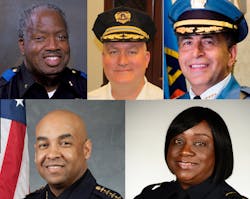There have been a series of incidents that have drawn national attention to controversial police actions. Transit police departments are no different and have been developing policies, increasing training and improving programs to build trust, boosting oversight and embracing community policing. And while there are many similarities between municipal policing and transit policing, there are significant unique factors for the transit police departments.
“We are immersed with the people,” said Southeastern Pennsylvania Transportation Authority Chief of Police Thomas J. Nestel III. “The unique thing about transit policing compared to municipal policing, most of our people are on foot with the customers, the riders, the citizens. Our cops are interacting with the public face to face, every day.”
New Jersey Transit Chief of Police Christopher Trucillo also has experience in both arenas. “I’ve done municipal policing and I’ve done the bulk of my career in transit policing and the transit police officer deals with hundreds of people every day and that’s not an exaggeration.” He continued, “A transit cop goes out to a transit station and literally has a sea of people go by in a 10-hour day.”
Both chiefs said their cops have developed long-standing relationships with people because they’re not in cars with the windows up like municipal police often are. The transit police are at the stations, riding the buses and riding the trains with the people.
Trucillo said, “I always joke and say that a transit cop can’t be an observer. A transit cop has to be an outgoing person and someone comfortable with people because a transit cop every day, all day, is in front of people.
“We message to our police officers and in our vision statement that everything we do has to be done with exceptional public service in mind. We understand that we police in an environment where people are paying to be there, to use our modes of transportation and that expectation of service is greater. We’ve got to deliver on that.”
The Transit Community
Another way in which transit police departments differ from a municipal officer is that transit police often deal with a larger quantity of people who are dealing with mental health issues, homelessness, and drug and substance abuse issues.
“One thing we know is that a lot of the folks with these types of social maladies congregate or navigate to and around transportation facilities,” said Trucillo. “That’s one of the challenges that a transit cop anywhere in our nation I believe, but certainly we here at New Jersey Transit face at all of our facilities.”
Bay Area Rapid Transit (BART) Chief of Police Kenton W. Rainey said the partnership they have with the National Alliance on Mental Illness (NAMI), has been a huge benefit to the department. The police department has a full-time licensed social worker that works with the officers in identifying homeless individuals who are suffering from mental illness and connect them up with the various program available in the community.
Also crucially beneficial is the 40 hours of crisis intervention training the officers receive. “A lot of agencies will send their officers to 8 hours training, maybe 16,” explained Rainey. “About 95 percent of our officers, and not just the police officers, our civilian staff as well, have undergone this training so they have a better understanding and empathy on how to deal with people who are suffering from mental illness.”
The training also includes a de-escalation piece when it comes to use of force and training to prevent racial profiling.
Talking further about the use of force reporting system, Rainey said while there are a number of layers of approval, they also have a civilian oversight and a police auditor that monitors all of the use of force incidents and has the ability to investigate or order further investigation.
Rainey said, “What I look at is how many of those complaints are being reversed. When we don’t find anything, we don’t feel our officer has done anything wrong. How much money we’re paying out in civil litigation regarding use of force complaints.
“I’m pleased with the direction that we’re going. The numbers have continuously gone down.”
Dallas Area Rapid Transit (DART) Chief of Police James D. Spiller explained a procedural justice and police legitimacy course they implement. While it wasn’t their idea, a lot of cities do a program like it, he said the course is getting back to basic policing: “It’s listening to people, allowing them to explain, empathizing with them and making a decision that’s fair and impartial and not going into it with some preconceived idea.
“What I always ask people is, how would you like to be treated?
“That gets the conversation started.
Spiller teaches the course himself because as he said, the mere fact that he’s doing it as the chief emphasizes the importance of it.
Face-to-Face with the Public
While transit officers are already out with the riders while doing their day-to-day job, every department has a different type of program that gets various levels of the departments and different divisions out to meet with the public and get a conversation started.
Metropolitan Atlanta Rapid Transit Authority (MARTA) Chief of Police Wanda Y. Dunham talked about the program at MARTA that takes the command staff out to a station to have meetings with the customers. And as she stated, “It can be good, bad or ugly.”
She explained, “They can tell us whatever they want to tell us. A lot of times they’ll tell us about service, things that we can’t do anything about.”
While they do pass that type of information along to the respected departments within MARTA, they’re asking customers how they’re doing, what would the customers like to see, and sharing what MARTA police is doing to make the ride more pleasurable.
“Some say you’re doing a great job. Others say they want more officers and I say I do too,” Dunham laughed.
They do these meetings quarterly to engage the public and to engage them weekly, the officers do Meet MARTA Police surveys on different lines. “We see what our customers are saying; it doesn’t fall on deaf ears. We make necessary adjustments from what customers tell us.”
DARTing with the Chief is an ongoing program with the Dallas Police Department where Dallas Police Chief David Brown and his command staff go out on trains as part of a community engagement effort to build a positive relationship with the community. DART Chief Spiller said the Dallas Police Department had more than 120 of its personnel and DART police had more than 60 or its personnel. “We were riding the trains talking with passengers about crime and expectations and general communication about some of their concerns and some of their issues and explain to them processes and procedures and ease their perception of what they thought was crime.
“We’re getting out with the public, communicating with them in a friendly way whereby we’re informing them of what’s happening with DART and letting them know not everyone is in uniform, which they are receptive to.”
Another way in which they’re engaging the customers in a dialogue is that they will go out and meet and greet customers and will ask them to fill out brief customer surveys, which are only a few questions. They will ask about security, about DART services, what the customers would like to see, what the customers think could be done better.
“We will fill out that form for them,” Spiller said. “We did over 40 of those within the last 6 months whereby we’ve reached over 5,000 customers that have participated with the survey.”
The customer can then opt for a personal response by email or phone and that will come back by no less than a supervisor.
“Sometimes they get a call from myself or my deputy chief,” Spiller said.
Being visible on the trains and buses and at the stations is critical. “Eighty-five percent of our trains are manned by a police officer or a fare enforcement officer and they ride that train and stay with it all day,” said Spiller.
One thing he likes to highlight is how they work with the employees, specifically the bus operators. Spiller said, “Quite often our bus operators will experience problems with riders and they have a mechanism where they complete a bus operator report and it’s completed online. We review all of those reports, so if an operator points out a problem on a specific route at a specific location, our officers will personally contact that operator and they will be at that bus stop, at that route and on that bus so that operator can point that person out and we can have a conversation with that individual.
On average, they’re doing more than 250 hours riding buses every two weeks and on station platforms or transit centers, they’re doing way more than 700 hours within a two-week period.
“That goes along with the amount of contact that we have not only with our customers, but our employees.” He stressed, “It’s important that employees feel safe and secure, just like our customers.”
Citizens Police Academy
Whether transit police or municipal police, departments have a variety of outreach programs to help them connect with the public. Police Explorer Scouts program works with the Boys Scouts of America or other non-profit organizations working with youth that may have an interest in a career in law enforcement. The McGruff program has been around for years to reach out to schools and younger children. And, National Night Outs bring a community together to build police-community relationships.
One of the things a few of the departments are doing is a citizens police academy. MARTA and NJ Transit both talked about how their respective citizens police academies operate.
MARTA has had a program for the past 20 years and last year combined it with a program that focuses on community emergency response. The program is a total of 14 weeks, with about 7 weeks focused on each area. Dunham explained, “We put the two together because what we found was a lot of people that went through the citizens police academy wanted to serve and vice versa.”
For the first 10 years the department did two classes a year and the last 10 years since Dunham’s been chief, they’ve gone down to once a year. It’s a staff-intensive program to make it of value to those that go through it, and she said they wanted to make sure they were getting the best bang for their buck.
Approximately 25 to 30 people go through the annual program.
Trucillo said the citizens police academy at NJ Transit has been in place for a number of years, sometime after 9/11. Unique to their program, the class of 17 to 22 people is made up of 50 percent employees. They do a program twice a year.
Some of the highlights to those going through the program, he said, are a ride-along with a police officer in the field, a driving simulator, information on the counter-terrorism program and going through the virtual shooting simulator.
During the 11-week program, he said they talk about each of the divisions and departments within the police department and bring in an array of members to talk to the class about what they do.
“It’s well-received on both ends,” he stated. “While we like to produce a good product for those that give us their time, our folks also enjoying having an opportunity to kind of beat their chest and talk about what they’re doing.”
Those that go through the class are surveyed at the end and last year they reached out to graduates, the alumni, to see if they would be interested in volunteering. “We were really surprised at the number who said yes, we would love to be involved,” Trucillo said. “We try to see where we can incorporate them and the last time we did was when the Pope visited our area.”
With an agency of more than 11,000 employees, there are a lot that may not know much about the police department. This program gives the department the opportunity to explain what they do. Trucillo said, “I think the employees, in some cases, are surprised to see how much the police department does within the New Jersey Transit that may transcend what their beliefs about policing is.”
The most challenging part of a citizens police academy? Time.
Trucillo said, it’s a quid pro quo. It takes employee commitment to put on a good training program and the commitment of the people who elect to give up a certain number of hours each week to the agency that put on the citizens police academy. “The way we feel here,” he said, “people are kind enough to give us their time; we really have to give them something special in return and that’s what we try to do.”
Blow the Whistle on Sexual Assault
The MARTA police department recently started a “Blow the Whistle on Sexual Assault” campaign. It kicked off October 7, 2015 and has a three-phased approach.
There’s not a huge amount of sexual assaults on MARTA, with only three in 2015. However, said Dunham, “To me, being a female, I think even one is too many.” She continued, “I wanted to lend out my voice to this initiative because I think for some folks, even though we’re happy with that, that they feel comfortable on MARTA, sometimes they get a little comfortable and we wanted to bring this initiative out.”
Phase 1: Handing out whistles.
Dunham said they purchased about 7,000 whistles and began passing those out to their customers and to the community. Customers appreciated MARTA was willing to have a program to protect them and look out for their safety and it garnered a slew of media coverage.
Initially they started out with handing whistles out during rush hour at designated stations. “You would be surprised people were so excited about getting a free whistle,” said Dunham.
Phase 2: Courtesy rides.
The second part of the safety campaign was providing courtesy rides. “This was a little challenging for our bosses,” explained Dunham, “because they were like, ‘hmmm, you know we’re not Uber, right?’
MARTA closes at 2 a.m. and this program is more than something for the person who’s bus has left. Dunham said it’s for the person standing alone on the platform at Midnight, or waiting for a bus and there’s nobody else around, and may not feel safe.
If they don’t feel safe, they can pick up a white or blue phone, or use the app and text you don’t feel safe, someone can come by and stand with that person or, if the person lives within a five-mile radius of a station, MARTA will take them home.
There were many concerns with such a program. Can we afford this? Will people abuse this?
Dunham stated, “They haven’t. They really, really have not.
“People have taken us up on our offer. To date we’ve given 194 courtesy rides, mostly between Midnight and 2 a.m.”
And, she stressed, it’s been the folks that really need it. The ones that have taken them up on the offer can’t stop thanking them enough, Dunham said.
“It’s mostly on the weekends, is what the trend is. We’ve found it’s mostly airport workers and folks who work for downtown … got out late and missed the train or bus.”
Phase 3: Self-defense class.
The final piece of the program is free self-defense classes in every jurisdiction that MARTA operates in. In December they held the final class of 2015 and they had reached that goal.
They’ve also given three classes to front-line employees, including station agents, cleaners and revenue agents. “They’re out there by themselves, too,” said Dunham.
“To date we’ve reached about 580 people. We’re excited about that.
“People are now calling us and we have several schedules for next year already.”
Technology Tools
Utilizing some of the latest technologies has enabled transit police departments to improve their training, provide tools riders can access and protect both riders and officers.
DART and NJ Transit use training simulators that give officers first-hand experience.
NJ Transit’s Trucillo said their officers go through a virtual 360-degree shooting simulator and driving simulator. DART’s Spiller said his officers go through TI Training Corp.’s The Training Lab use-of-force and firearms theater-style simulator.
Spiller said the simulator is transit-focused and officers are put in a scenario where they may be confronted by an individual with a knife who is acting erratically. “You have to go through the procedures of de-escalating the situation that you’re in.” That may involve the use of force, whether it’s with a baton, pepper spray and eventually maybe the use of a weapon.
“We use it for critical decision-making,” Spiller said.
It’s very realistic, complete with the sound of guns firing. Other staff has also gone through the simulator, including members of DART’s communication staff and attorneys.
“What we’ve learned by staff … going through it,” Spiller explained, “They would ask questions of us and we could explain our actions to them. More importantly, they would have to explain their actions to themselves, which helped us in the long run, and it helped all of us get a better understanding of what an officer confronts and has to deal with on a daily basis.
Read more about the simulator, from DART Digital Media Specialist Travis Hudson at www.MassTransitmag.com/12159204.
Many departments are using or testing body cameras on officers. Officers are required to turn on the camera any time they make any type of enforcement contact and record the incident from start to finish.
BART’s Rainey said it protects the citizens and officers as far as preserving the evidence about what really happened if there’s a complaint.
“We’ve been in the camera business a little over three years,” he said. They use Axon Taser Flex body cameras.
“The officers were a little reluctant but they definitely have come around because it really goes a long way to ensure transparency.
“The cameras can tell what happened. You still have to do an investigation but the cameras go a long, long way in ensuring transparency.”
As of this interview, DART police were testing body cameras and were expecting to start the procurement process within about a month. NJ Transit had just completed a pilot program with Taser International body cameras and were looking to outfit officers in the first quarter of 2016 with body cameras.
The Impact of Social Media
Ever-changing technology impacts community relations for the police departments. Rainey said the biggest challenge they face is that everybody is so interconnected. “When something happens in Oakland, or San Francisco, or even across the country, people want to come back to BART because of that original high-profile event in 2009, Oscar Grant.
“We have to remind everybody, yeah, we did have that incident. But we’re totally a different agency. If you look at the stuff that was recommended in the president’s 21st Century Policing Task Force report, many of those recommendations we are either doing or have done.”
And some are using that kind of technology to their favor.
Nestel came to SEPTA in August of 2012 and he was already using Twitter. “From the day that I walked in the door, that was one of the things that I was doing.
“And it does make the media relations folks, the CEOs, executive staff, it makes them nervous.”
He explained, “Look, I’m exposing myself and by exposing myself, I’m exposing my organization. One unintended blip could be a devastating disaster.”
He emphasized, “In order to have success, you have to take risk.
“It’s calculated risk and it’s reasonable risk, but it is risk.”
Nestel said the focus of his tweeting is to market the products and to let people know about the great work the transit police is doing on the system.
Measuring the return on investment of social media can be complicated, but Nestel and SEPTA Pbulic Information Manager Andrew Busch provided
SEPTA does a robust customer survey every couple years and the last survey saw a dramatic increase in customer satisfaction with safety and security. And, it’s not only built a relationship with the riders, it’s built a relationship with the media.
“It’s a mixed bag,” said Nestel. “Look, if I don’t tweet about it, it’s not a story.”
“Sometimes I’m tweeting about things just because I want people to know that I’m transparent. I put the good with the bad.”
Nestel referenced a recent example where he tweeted about the arrest of one of their own officers. He said, “The media would have never known about that had I not tweeted about it.”
Busch gave the media relations’ perspective. While they were nervous, it’s been tremendous in terms of increasing SEPTA’s profile, he said. Even when there’s an incident, not necessarily a positive event, since the chief’s been on board he said it’s put them on better footing. “It certainly has helped our credibility. We’re very much transparent.”
Credibility and transparency are key.
“You have to talk about the bad with the good,” Nestel said. “To be credible, sometimes you have to talk about the bad, too. And, you just can’t be a rosy, always-present person when good stuff is going on and then disappear when the bad stuff occurs.
As he explained, “It gives a great opportunity for me to give, in 140 characters, a short explanation or a short statement or a short expression of disappointment. I think it personalizes policing for me.
“It sounds like a cute, catchy idea but it is very risky. However, the rewards can be overwhelming.”



